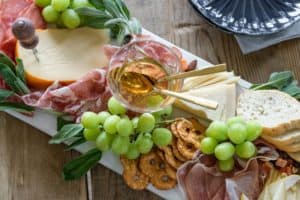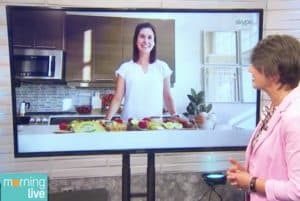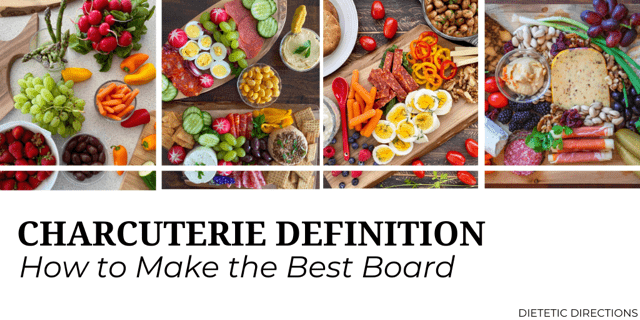
Charcuterie Definition & Board Ideas!
What is the charcuterie definition? Are you looking for charcuterie board ideas? Well, first things first. Let’s review the charcuterie definition because you WANT to get on ‘board’ with this social media craze. Then, you too will be the one posting beautiful pictures of your meat, fruit and cheese spreads. So today’s blog will not only define charcuterie, but also give five ways to get creative with cool, unique (and healthy) charcuterie boards. These colourful spreads can be enjoyed as an entertaining appetizer or even as a nutritionally balanced meal.

This post was sponsored by the Egg Farmers of Ontario, as always, all opinions are genuine.
What is the Charcuterie Definition?
Noun: Charcuterie describes cold cooked meats; with French origin from ‘char’ meaning meat and ‘cuite’ for cooked. Historically, charcuterie referred to pork products (pate, bacon, sausage, ham, terrines). The expanded, modern definition of charcuterie includes other sources of protein such as chicken and duck. Plus, a variety of other foods such as cheese, crackers, olives, fruit, etc. have been added. Pronounced: char·cu·ter·ie
My Charcuterie Definition:
Putting an array of colourful foods, protein sources and carbohydrates on a wooden board or platter for human consumption. Additionally, these can be enjoyed as an appetizer or a complete meal.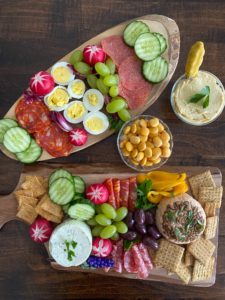
Now, that you know the charcuterie definition, let’s ‘cut’ into how to make the best boards!
What you’ll Need for your Charcuterie Board:
- Wooden board for arranging foods: A handle on the board is helpful for serving and carrying. Use a platter or marble slab, if you prefer.
- Variety of small bowls for placing dips, mustard or small fruits or veggies. Additionally, use measuring cups for a cool, classy-looking ingredient holder. With small bowls, go for a variety of colours, sizes, shapes and materials.
- Utensils: You will need some knives for cutting cheese or spoons for scooping pate or dips. Forks or toothpicks are also helpful for moving ingredients from the board onto your plate.
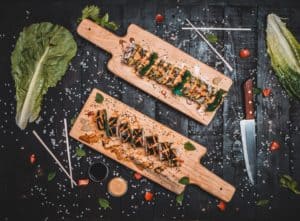
5 Tips for Building Charcuterie Boards:
1. Colour is Key
What makes a charcuterie board beautiful is seeing an array of colours! When building your board, entertain the eye by adding at least three colours with fruits and unique, vibrant veggies. And place colours in different areas to highlight sections of the board.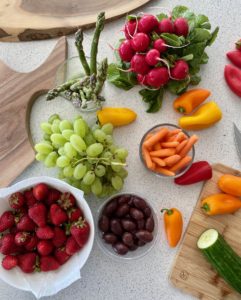
Add an array of colours on your charcuterie board!
Without a doubt, colourful foods create visual interest and appeal. Offering veggies at meals (or appetizers) and displaying them beautifully encourages consumption. Another strategy for building colourful charcuterie boards is cutting veggies into different shapes – small pieces, sticks or thinly sliced. You can then place these beside a dip. Research supports that dips increase veggie consumption.Examples of Colourful Charcuterie Board Foods:
- Red/green grapes
- Strawberries or raspberries
- Cherries (plus a tiny bowl for pits)
- Blackberries or blueberries
- Figs
- Carrots
- Radishes
- Sliced apples with peel
- Snap peas
- Roasted peppers or raw pepper strips
- Cherry tomatoes or heirloom tomatoes
- Dried apricots, prunes
- Fresh herbs (mint leaves, parsley or basil)
- Garnishes (arugula, cabbage leaves or endive for holding ingredients)
- Green or black olives
- Edible flowers
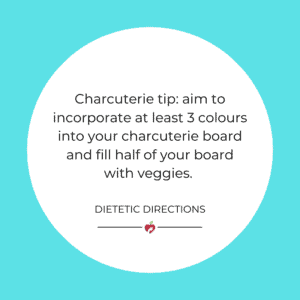
2. Mix Up Your Proteins
The charcuterie definition traditionally refers to cooked meats; however, don’t let that limit you. Instead, think outside “customary” protein sources. This allows your charcuterie board to include options such as hard-cooked eggs, beans or legumes, fish pate, and unique nuts/seeds. To be clear, we do not need to shy away from enjoying meat or cheese, but just expand the protein possibilities.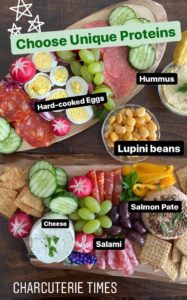
Charcuterie Board Protein Tip: Choose at leasttwo to three different proteinoptionson your board andat least five optionsif entertaining a group.
Think Outside the Carton:
Just recently, I was putting together a lunch charcuterie board and was looking for unique, healthy protein options. Luckily, I always have hard-cooked eggs in the fridge and felt inspired to include them on my board! After all, eggs are an awesome source of complete protein with 6 grams per egg and only 70 calories. They’re also rich in 14 essential minerals such as choline for the brain and lutein for eyes. Additionally, Ontario eggs go from the farm to the grocery store in only 4 to 7 days – delicious and always fresh! For my lunchtime Charcuterie Board, I slice hard-cooked eggs into coins and fan them for easy scooping.

Legumes or Beans?
When planning proteins for your charcuterie board, why not include beans and/or legumes? These heart-healthy additions are packed with fibre (about 8 grams per half cup), protein (about 9 grams per half cup) along with minerals such as iron, potassium, magnesium, and folate. Beans are also very economical (click here to save on your groceries with inspiration from my Cheap, Healthy Meals blog post).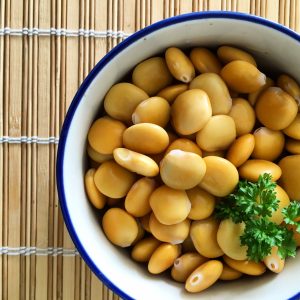
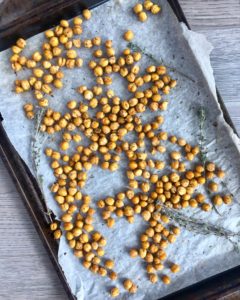
Charcuterie Protein Ideas (choose 2 or 3 options):
- Romano beans or bean salad.
- Hard-boiled eggs.
- Lupini beans.
- Cheese – hard cheese, soft cheese, robust-flavored, spicy, etc. I love supporting local withMountainOak gouda. They have award-winning cheese in a wide variety of flavours (Smoked, GOLD and Wild Nettle are my favourites). Other charcuterie cheeses include Swiss, bocconcini, brie, and jalapeño cheddar.
- Unsalted, roasted nuts, and seeds (almonds, cashews, or pistachios).
- Salami or cured meats like prosciutto.
- Smoked salmon antojitos or smoked salmon cucumber bites.
- Salmon/shrimp/crab pate.
- Yogurt or cottage cheese.
- Devilled eggs.
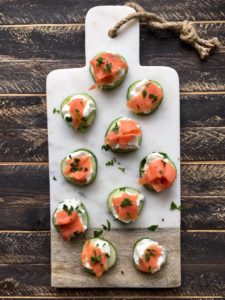
3. Count on Some Carbs!
Now that you have a variety of colourful foods and a couple different proteins on your charcuterie board, let’s ensure you have carbohydrates. After all, carbs are our body’s preferred source of energy/fuel and a vital part of a nutritionally balanced meal. Additionally, they are NOT bad (please read my blog post In Defense of Carbs: Stop the Hating if you fear carbs). Nevertheless, carb sources are necessary on a charcuterie board to keep us feeling full and satisfied. We want to choose “complex carbs” more often, which refer to less processed options with higher fibre and vitamin/mineral content. Carbs also fuel our muscles for physical activity and support brainpower. Additionally, people love having crackers with their cheese or dips, so including them as an option on your board is a guaranteed way to please guests!
Nevertheless, carb sources are necessary on a charcuterie board to keep us feeling full and satisfied. We want to choose “complex carbs” more often, which refer to less processed options with higher fibre and vitamin/mineral content. Carbs also fuel our muscles for physical activity and support brainpower. Additionally, people love having crackers with their cheese or dips, so including them as an option on your board is a guaranteed way to please guests!
Charcuterie Board Carbohydrates Examples:
- Whole-grain crackers. (Opt for higher fibre and low salt when possible).
- Pita chips or baguette bites. (These can be homemade or store-bought).
- Fruits. (Technically a carb source even though they are also included above as colouful foods).
- Toast – ideal for easy lunch boards.
- Pretzels. (Could also have homemade pretzel bites).
- Dried fruits (apricots, prunes, dates).
- Breadsticks or melba toast.
TIP: Choose 2 to 4 different carbohydrate sources for your board and add them at the end to fill empty spaces on your board.
4. Dips, Sauces, and Spreads
What’s a charcuterie board without dips, sauces or spreads? Go for a variety with at least two dips for meals and more options if entertaining. Dips make everything more exciting! Those crackers and veggie sticks become vehicles for dip consumption. Not to mention, dips are an inevitable crowd-pleaser. Who is not impressed with a homemade (or store-bought) Tzatziki or a beet hummus on a charcuterie board? Finally, be sure to use your small bowls, measuring cups, or lids to display your fancy dips to guests.
Here are some dip, sauces or spread ideas:
- Hummus
- Grainy mustards
- Jellies or jams (fig jam or habanero pepper jelly)
- Yogurt or cottage cheese
- Salmon pate or smoked salmon
- Bruschetta mix
- Caramelized onion French dip
- Salsa
- Tzatziki
- Spinach and artichoke dip
- Pickled eggplant (popular among my Italian relatives)
- Walnut Lime Pesto
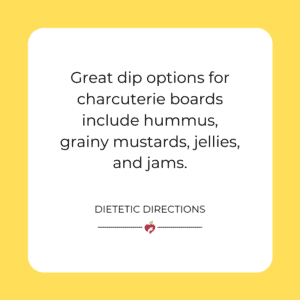
TIP: Need some fun new meal ideas? Try a charcuterie-style lunch! This is a creative alternative to a traditional sandwich and can be put into a bento box to enjoy a variety of tasty foods on the go.
5. Charcuterie Board Ideas!
Finally, bring your charcuterie board together with a theme. You certainly do not need to have a theme, but it sure adds creativity. So, if you have a colourful board, a variety of proteins, and carbs with some dips, then you WILL have a delicious and nutritionally balanced board.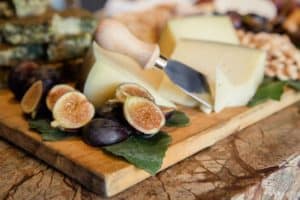
Expand Charcuterie Definition with Themes:
Breakfast Charcuterie Board
- Mini pancakes/waffle triangles/French toast fingers, fresh fruits and berries, maple fennel bacon, yogurt/cottage cheese.
Lunch Board
- Hard-cooked eggs, carrots, berries, cottage cheese, cherry tomatoes, MountainOak gouda, walnuts, Romano Beans etc.
Cheese Board
- Hard cheese, soft cheese, blue cheese, blackberries, crackers, strawberry jelly, dried apricots and walnuts, Italian-Style Romano Beans, and edible flowers.
Veggie Board
- Blanched asparagus (put in boiling water for one minute and then into an ice bath), snap peas, cucumbers sprinkled with little Kosher salt, radicchio, Greek Yogurt Tzatziki Dip, whole-grain crackers, olives, and Lupini beans.
German Board
- Pretzels, summer sausage, roasted or fried potato balls, rosemary sprigs, carrots, sausage in coins with toothpicks, pickles, apple slices and sauerkraut.
Italian Board
- Genoa salami, olives, prosciutto, Italian parsley, crusty bread, bocconcini, radicchio, cherries, grapes, grilled artichokes, eggplant, and bruschetta mix.
Pizza Board
- Pepperoni pieces on sticks, black olives, crackers, sliced peppers, mozzarella cheese cubes, roasted red peppers, mushrooms, fresh basil, tomatoes, and marinara dipping sauce.
Dessert Board
- Mini chocolate squares, strawberries, fruit, cherries, pretzel sticks, caramel dips, yogurt dip, bite-sized brownies, nuts, and prunes/apricots.
Go Local Board
- See what’s at the local farmer’s market – radishes, carrots, beans, go with what is available! Be sure to add different colours, a couple proteins, a carb source, and maybe something to dip. Here’s what’s in season in Spring, Summer, and Fall!
Peanut Butter Board
- Sliced banana, mini toasts/waffles, peanut butter in bowl, chocolate chips, pretzel sticks, strawberries, celery, whole-grain crackers and yogurt.
Under The Sea Board
- Salmon pate, cucumbers, shrimp cocktail, Smoked Salmon Antojitos, rice crackers, seaweed salad, sliced peppers, olives and cheese cubes.
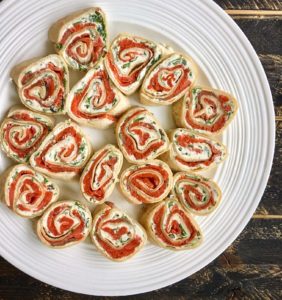
Smoked Salmon Antojitos work well on a charcuterie board!



